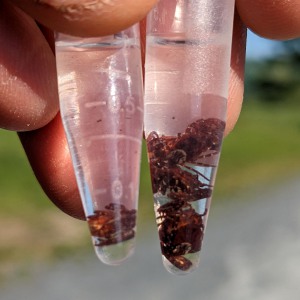Officials try to get a grip on cyanobacteria in Lake Morey
| Published: 09-17-2022 11:04 PM |
FAIRLEE — Lake Morey is suffering a cyanobacteria bloom that town officials are calling “the worst in recent memory.”
The lake has struggled with the bacteria in the past. It blooms up in dense blue-green patches each summer, tangling up swimmers, canoe paddles and fishing lines. Some cyanobacteria produce toxins that can cause health effects, ranging from rashes to nausea, to more severe liver, respiratory and neurological harm — even from low-level exposure.
But this year has seen so much algal activity that in some sections of the lake thickets of algae are sticking far enough out of the water that they dry up, turning gray and powdery in the sun.
Drought conditions and hotter-than-usual temperatures this summer aren’t helping. Cyanobacteria thrives in warmer water, which causes it to reproduce faster and inhibits lake turnover.
The town beach has been closed now for three weeks.
“With the long, hot weather and not much water coming in, this bloom was pretty significant,” Selectboard Chairman Peter Berger said. “People really haven’t seen anything like it.”
Cyanobacteria is naturally found in water bodies, but blooms can get out of control when excess nutrients are present. Phosphorus from agricultural and development runoff, or chemicals leaking out of septic systems, fuel growth.
For now, the town is working with state officials from the Department of Environmental Conservation, as well as members of the Lake Morey Commission, in gathering data on the blooms so they can better advise residents and get it cleaned up.
Article continues after...
Yesterday's Most Read Articles
 Football helmet maker buys Lebanon’s Simbex
Football helmet maker buys Lebanon’s Simbex
 James Parker granted parole for his role in Dartmouth professors’ stabbing deaths
James Parker granted parole for his role in Dartmouth professors’ stabbing deaths
 Zantop daughter: ‘I wish James' family the best and hope that they are able to heal’
Zantop daughter: ‘I wish James' family the best and hope that they are able to heal’
 Kenyon: Dartmouth alumni join union-busting effort
Kenyon: Dartmouth alumni join union-busting effort
 Parker up for parole more than 2 decades after Dartmouth professor stabbing deaths
Parker up for parole more than 2 decades after Dartmouth professor stabbing deaths
 Through new school partnerships, CRREL seeks to educate young scientists
Through new school partnerships, CRREL seeks to educate young scientists
“We really need to be data-driven,” Berger said, adding that the town is hoping to soon host a forum with state officials so that scientists can address town members directly.
“What I’ve been pressing is that the causes should be looked at as being on a pie chart,” Fairlee Health Officer Chris Brimmer said. “Part of its going to be nutrients at the bottom of the lake, part of it’s climate change, part of it may well be septics around the lake. Right now, what we don’t have a handle on his how big the wedges in the pie chart are.”
In the past, the town has taken a number of measures to prevent cyanobacteria blooms, like a moratorium on building along the lakeshore. But this summer’s bloom has left officials talking about more aggressive treatment. Depending on the available funding and results from the data, the town might consider an alum treatment, which would remove the excess nutrients fueling the bloom, Berger said.
Officials are currently advising against swimming — keep dogs and children out of the water, Brimmer said. But if for some reason a resident does end up making contact with the lake, he has some advice:
“Hose off.”
Frances Mize is a Report for America corps member. She can be reached at fmize@vnews.com or 603-727-3242.

 Out & About: Vermont Center for Ecostudies continues Backyard Tick Project
Out & About: Vermont Center for Ecostudies continues Backyard Tick Project Art Notes: After losing primary venues, JAG Productions persists
Art Notes: After losing primary venues, JAG Productions persists  Over Easy: Marvels in the heavens, and in the yard
Over Easy: Marvels in the heavens, and in the yard  Amid financial difficulties, Lebanon-based Revels North cancels midwinter show
Amid financial difficulties, Lebanon-based Revels North cancels midwinter show 
